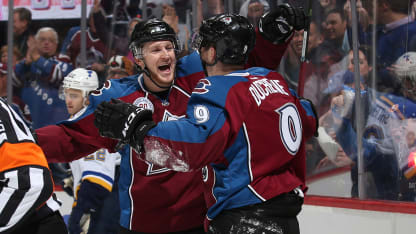NHL.com is providing in-depth analysis for each of its 30 teams throughout August. Today, the biggest reasons for optimism and the biggest questions facing the Colorado Avalanche.
Rather than making wholesale changes after the Colorado Avalanche missed the Stanley Cup Playoffs for the second straight season, general manager Joe Sakic is putting the onus on his core of talented young players to return to the postseason.
First, Sakic needs to find a replacement for coach Patrick Roy, who resigned Thursday, saying in a statement that he didn't have enough input in player personnel decisions.
Reasons for optimism, questions facing Avalanche
New direction in store following resignation of coach Patrick Roy

© Michael Martin/Getty Images
By
Rick Sadowski
NHL.com Independent Correspondent
The Avalanche were serious contenders for the second wild card into the playoffs from the Western Conference before losing eight of their final nine games, including six straight, last season.
Here are four reasons for optimism entering this season:
1. New coach, new direction
No one can question Roy's passion for winning, or his desire to return the Avalanche to the elite status they had during his playing days, but the potential for a change in philosophy under his replacement could be a positive step.
Colorado was a poor puck-possession team under Roy, who occasionally downplayed the importance of analytics with cynical remarks about advanced statistics.
The Avalanche have a stable of young, talented forwards, but they haven't been able to use their speed as the advantage it should be on a consistent basis while spending so much time in their own end. They need quick and better outlet passing from the defensemen, and the addition of former NHL defenseman Nolan Pratt as an assistant coach could help in this area. He was an assistant last season for Lake Erie's Calder Cup championship team.
Was Roy's message not getting through to players after three seasons of hearing the same things over and over again? A fresh approach might be just what the Avalanche need to get back on track.
2. A healthy, hungry Nathan MacKinnon
The 2014 Calder Trophy winner is vowing to take on more responsibility in his fourth NHL season after signing a seven-year, $44.1 million contract on July 8. Inconsistency and injuries hampered his play the past two seasons; a fractured foot cost him the last 18 games in 2014-15, and he missed the final 10 games last season because of a knee injury.
Those injuries, to a large degree, have kept MacKinnon from equaling the scoring of his rookie season, when he had 63 points (24 goals, 39 assists) in 82 games as an 18-year-old.
The center, who will turn 21 on Sept. 1, is one of the fastest skaters in the League, capable of powering his way through the neutral zone. He should excel as the Avalanche's No. 1 center, his natural position, on a full-time basis.
"I think I have a lot to prove in this league," MacKinnon said. "I think I can take my game to a whole other level and I'm really excited to show it this season, especially with this new contract. There's a lot of pressure to perform, and I'm looking forward to the challenge."
3. Breakout time for Matt Duchene
After missing the playoffs five times in his seven NHL seasons, Duchene is determined to help turn the franchise he followed as a child into a consistent postseason team that eventually can compete for the Stanley Cup.
Duchene, 25, should be ready to take his place among the League's top centers after scoring 30 goals for the first time despite missing six games because of a knee injury. He was the first Avalanche player to score 30 or more goals since Sakic (36) and Milan Hejduk (35) in 2006-07.
4. Calvin Pickard will push Semyon Varlamov
Varlamov remains the No. 1 goalie, but Pickard has shown he's more than capable of handling the load should Varlamov falter or sustain an injury. Pickard won the backup position after shuttling between the American Hockey League and the Avalanche the past two seasons; he signed a two-year, $2 million contract July 5.
Varlamov is brilliant at times but hasn't managed to match the consistency of his 2013-14 season, when he was a finalist for the Vezina Trophy.
Here are three key questions facing the Avalanche:
1. Did they do enough to improve a questionable defense?
This has become an annual concern. The Avalanche allowed 40 or more shots 14 times last season, when Varlamov and Pickard were too often under siege behind a team that couldn't get the puck out of the defensive end. The lone newcomers are free agent signees Fedor Tyutin and Patrick Wiercioch.
Puck-moving Tyson Barrie, who signed a four-year contract reportedly worth $22 million on July 31, is an asset on offense but can be a liability in his own end. Erik Johnson has to rebound from a poor season (27 points, minus-19 rating in 73 games), and it's probably too much to ask Francois Beauchemin, who turned 36 on June 4, to average 25 minutes again.
The Avalanche are counting on young players Chris Bigras and Nikita Zadorov, each 21, to develop at a fast rate. An elbow injury limited Eric Gelinas to six games following his Feb. 29 acquisition from the New Jersey Devils.
2. Will home ice be an advantage?
The mile-high altitude didn't help last season, when the Avalanche went 17-20-4 at Pepsi Center, the third time they finished under. 500 at home since arriving in Denver in 1995-96. They were 1-4-1 in their first six home games, 2-6-1 in their first nine and 0-5-0 in their final five.
3. Can they avoid another poor start?
The Avalanche lost nine of their first 14 games last season, including a disheartening 5-4 loss to the Minnesota Wild at home on opening night after taking a 4-1 lead into the third period. Two seasons ago, the Avalanche lost six of their first seven games and 13 of 17 after opening with 5-0 and 3-0 losses to the Wild. They'll be tested early this season with five of their first seven games, and six of the first nine, on the road

















